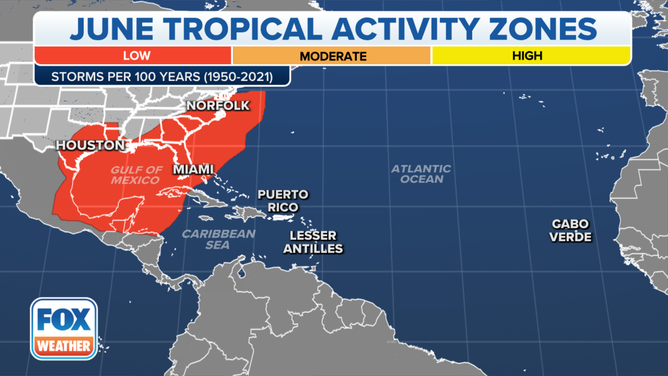No June on record has had 2 storms form in tropical Atlantic waters east of Caribbean islands – until now
The month of June is usually not very active in the tropics, and any named storms that do form typically develop closer to the U.S. in the Gulf of Mexico, the western Caribbean Sea and near the Southeast and mid-Atlantic coasts.
Tropical Atlantic comes alive with active start to 2023 hurricane season
We're only a few weeks into the 2023 Atlantic hurricane season and we've already had two named storms. And with Invest 93L continuing to strengthen, we may see our third named storm in the coming days.
It’s been an unusually active start to the 2023 Atlantic hurricane season, with the development of Tropical Storm Arlene on June 2 and Tropical Storm Bret on June 19.
And spinning off to the east of Bret was another system that the National Hurricane Center (NHC) kept its eye on – Tropical Storm Cindy.
The tropical disturbance moved off the coast of Africa on the heels of Bret last week and slowly showed signs of strengthening. As a result, the NHC upped the chances of development for Invest 93L and then it strengthened into a tropical depression before developing into Tropical Storm Cindy.
The 2023 Atlantic hurricane season is now one for the history books.
HOW TO PREPARE FOR HURRICANE SEASON
Rare June tropical Atlantic activity
According to Dr. Phil Klotzbach, a meteorologist and world-renowned tropical weather expert at Colorado State University, there has been no hurricane season on record in June in which two storms have formed between Africa and the Lesser Antilles.
Bret was forecast to become a hurricane but never made it to that strength. It would have been only the third hurricane on record to form east of the Lesser Antilles in June. The first was storm "Two" in 1933 and then Elsa in 2021.
Two other tropical storms, Ana in 1979 and Bret in 2017 formed east of the islands.
The formation of Tropical Storm Cindy now means two storms formed in the month of June to the east of the Lesser Antilles - making it the first time in history that that has occurred.
The month of June is usually not very active in the tropics, and any named storms that do form typically develop closer to the U.S. in the Gulf of Mexico, the western Caribbean Sea and near the Southeast and mid-Atlantic coasts.
Between 1851 and 2020, only 6% of tropical storms and 2% of hurricanes roamed the Atlantic during June, according to NOAA's Atlantic Oceanographic and Meteorological Laboratory data.

This map shows where tropical cyclone activity tends to occur during June. The data are shown as the combined number of tropical depressions, tropical storms and hurricanes whose centers pass within 125 miles of a point on the map during a 100-year period. The analysis is based on data from the 72-year period from 1950 to 2021 but normalized to 100 years.
(FOX Weather)
It’s rare for multiple disturbances to develop into tropical storms this early in the season, as the first named storm doesn't typically form until June 20.


